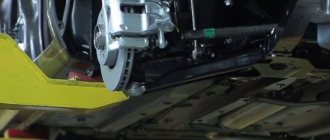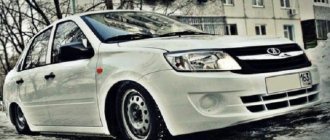- Main overall dimensions and parameters
- Trunk dimensions in centimeters Lada Vesta cross version
- Available useful options for the new body
- Powertrains and transmission
- Trunk capacity
- Equipment of Lada Vesta Classic cars
- Classic/Start
- Comfort
- Comfort/Image
- Comfort/Multimedia
- Luxe/Multimedia
Main overall dimensions and parameters
Lada Vesta is a 4-door spacious sedan, the interior of which is designed for five people. In 2021, the AvtoVAZ concern plans to release a restyled version of the sedan and begin sales of a new body version - the Lada Vesta station wagon.
| Parameter | Unit | Meaning |
| Body length/width/height | mm | 4410/1764/1497 |
| Wheelbase | mm | 2635 |
| Front/rear wheel track | mm | 1510/1510 |
| Clearance | mm | 178 |
| Trunk volume | l | 480 |
| Fuel tank volume | l | 55 |
| Curb weight | kg | 1230 |
| Maximum weight | kg | 1670 |
| Drive unit | Front | |
| Front/rear suspension | Independent/semi-independent with anti-roll bar | |
| Front/rear brakes | Disc/drum |
Having impressive dimensions, the SV and Cross versions have really good luggage compartments. For the first time, a double bottom design is presented here, and the factory abandoned the rear shelf in favor of curtains, which further increased the usable volume.
At the same time, the Lada Vesta Cross model received additional hangers and mesh pockets for small items. However, there are similarities:
- The false floor is retracted, freeing up a spacious niche for additional cargo.
- The side compartments are made with a solid frame, which guarantees the safety of fragile cargo during transportation.
- The useful volume of the luggage compartment is equal for the SV and SV cross models.
- The height and dimensions are identical.
The disadvantages of the car include the poorly thought-out double floor of the luggage compartment. The high threshold formed when the door is opened deepens an additional 15 cm, which complicates the loading of heavy objects. Thus, manipulations have to be carried out exclusively with the step - this imposes additional inconvenience when working with large loads.
The next drawback is the incomplete folding of the seats. The backrests of the structure recline at an angle of 55˚. Therefore, packing long items will be problematic. In some exceptions, buyers complain that after heavy rain or pressure washing, water gets into the trunk of the Lada Vesta.
Such problems are normal for the manufacturer and are considered normal among users. In this case, experts recommend contacting a service center to replace the seals. If the factory service period has expired, the cost of a new rubber band starts from 1000 rubles. In more severe cases, leaks form at the joints of windows.
Thanks to the thoughtful design of the internal parts of the interior panels, engineers were able to fit an impressive trunk into a medium-sized frame. All useful capacity guarantees easy transportation of small furniture or a comfortable trip to the sea or on a camping trip with the whole family. At the same time, there is no shortage of free space.
The standard compartment dimensions are as follows:
- standard volume – 480 l;
- without raised floor – 575 l;
- with seat backs folded - 875 liters.
Clear compartment opening:
- between arched posts – 980 mm;
- maximum width – 1340 mm;
- from the lid to the seat backs – 930 mm;
- maximum length to seat backs – 1820 mm;
- minimum vertical clearance – 660 mm;
- maximum vertical clearance – 830 mm;
- threshold height from the ground – 110 mm;
- raised floor width – 900 mm;
- raised floor length – 940 mm;
- height of additional compartment – 110 mm/with lid – 80 mm;
- capacity of additional niches – 30 l.
General conclusions and practical assessment
The compact trunk of the LADA SW Vesta is somewhat inferior in capacity and volume to other competitors in this class. However, due to the proper organization of space and the ability to conveniently use all functions, the car gained high marks from car enthusiasts.
Thanks to the folding rear row, the car is perfect for transporting large cargo and tourist trips. Therefore, many analysts and specialists are confident that the SV version can become a priority for the domestic market in 2021.
Sources:
https://xn--80aal0a.xn--80asehdb/reviews-tests/lada-vesta-reviews-tests/2662-kakoy-obem-i-razmery-bagazhnika-u-lada-vesta-sw-universal.html https ://vaz-russia.com/remont-lada-vesta/bagazhnik-lada-vesta-razmery.html https://lada-vesta-sw.ru/ob-em-bagazhnika-lada-vesta-kross/ https: //infokuzov.ru/kuzov/bagazhnik-lada-vesta https://ixray.ru/volume-of-luggage-lada-vesta-sw-universal
Trunk dimensions in centimeters Lada Vesta cross version
Trunk measurements in liters are not always clear for understanding the actual dimensions, so they resort to measurements using a tape measure and indicating the values in centimeters. This approach will not leave questions unanswered even for the most inquisitive car enthusiasts. When measuring the luggage compartment of the West Cross with a tape measure, the following values were obtained:
- The depth from the rear row of seats to the plastic trim at the edge is 93 cm.
- The depth from the top of the seats (perpendicular) to the edge of the trunk is 70 cm.
- The depth to the front seats (with the rear row seats folded) is 170 cm.
- The width of the trunk to the wheel arch is 120 cm.
- The width in the wheel arch is 98 cm.
- The opening size is 100 cm.
- The height of the opening is 86 cm.
- The height of the opening from the additional raised floor to the roof of the car (bypassing the curtain) is 70 cm.
In addition to additional niches built into the floor, the cross version of the car also has side niches equipped with nets, hooks and special holding devices for containers with technical fluid.
Powertrains and transmission
Car power unitToday, Lada Vesta is equipped with two four-cylinder 16-valve gasoline engines:
- the base 1.6-liter power unit has a capacity of 106 “horses”;
- a more powerful 122-horsepower engine of 1.8 liters in volume.
Vehicle performance depends on many factors, including the selected transmission.
| 106 hp, 1.6 l, manual transmission | 106 hp, 1.6 l, robot | 122 hp, 1.8 l, robot | |
| Acceleration 0-100 km/h (s) | 11.2 | 14.1 | 12.1 |
| Maximum speed (km/h) | 175 | 178 | 186 |
| Average fuel consumption per 100 km (l) | 6.9 | 6.6 | 7.2 |
How can you save money?
At the same time, prices from official dealers are very high. To save money, you should visit the website of your favorite online store and then check the availability of the required product. Don’t be lazy to look, because often the savings can be quite serious (1000 rubles or more). In addition, you can find the website of a company that produces such accessories (after all, AvtoVAZ itself does not make luggage racks, but only sells them). Thus, you can save an additional 1.5-2 thousand. Quite good, just needs a little effort.
It will also be interesting to read: Hyundai Creta 2021: technical specifications, price, equipment
True, you should not buy goods from unverified sellers, because there is a high probability of running into a fake. It is better to trust reliable suppliers, so you can get the highest quality product for an affordable amount.
Trunk capacity
The interior space of the Lada Vesta trunk is reduced due to the sloping location of the compartment lid. However, thanks to the impressive parameters of the machine, this drawback is leveled out. The useful volume is 480 liters, regardless of modification. This space is quite enough for a family trip or active recreation.
However, if necessary, the size of the Lada Vesta trunk can be increased to the required criteria. By removing the false floor, an additional 95 l are released. which totals 575 cubic decimeters of space. If that's not enough, the rear seats fold down when loading large structures, freeing up a total of 875 liters of free space, which is comparable to classic SUVs.
At the same time, the length of the flat surface is 170 cm. These indicators are enough for a snowboard, skis or a small refrigerator. At the same time, there is a well-thought-out second luggage compartment shelf. The top compartment allows you to stack a second row of bags on top of the first without risk of damage to the contents. However, the design also has disadvantages.
What is the actual trunk volume of the Vesta SV Universal?
The Vesta SW station wagon model is the first domestic car to use a special body structure design technology.
The roof sloping towards the rear is considered the hallmark of all modern station wagons. Thanks to this design solution, the manufacturer managed to improve the streamlining and appearance of the car.
However, the introduction of this body option significantly affected the overall practicality of the car. After all, the specific shape prevents the installation of classic versions of luggage racks. Accordingly, there is a reduction in useful space inside for the transportation of various goods.
According to the manufacturer, the volume of the luggage compartment of the SV version when folded is 480 liters, which is actually no more than that of serial sedans. If necessary, the car owner has the opportunity to fold the rear row of seats to obtain a 60/40 distribution of free space and a total volume of 850 liters.
The data is not so impressive for a station wagon, but all shortcomings are compensated by the presence of a large number of auxiliary niches and pockets.
Proper distribution of things allows you to increase the usable volume. It is worth noting the quality of the trunk finishing, which is made mainly of high-strength dark-colored plastic.
Equipment of Lada Vesta cars
The modern Russian sedan Lada Vesta has several trim levels: Luxe, Comfort, Classic. In addition, the standard set of equipment can be supplemented with option packages. The Classic package is equipped with the Start package, the Comfort version has an Image and Multimedia package, and the Luxury version has only Multimedia.
Classic
Classic model The basic configuration has a solid list of options at its disposal:
- airbags for driver and front passenger;
- “child lock” on the rear doors;
- automatic door locking while the car is moving;
- ISOFIX child seat mount;
- immobilizer;
- signaling;
- 3 headrests for second row passengers;
- ERA-GLONASS system;
- ABS is a system that limits brake locking;
- ESC is a system that provides directional stability;
- EBD – braking force distribution;
- HSA – hill start assist;
- TCS – system that prevents wheel slip;
- protection of space under the hood;
- folding backrest of the rear sofa in a ratio of 60/40;
- availability of 12V socket;
- gear shift prompt;
- on-board computer;
- electric power steering;
- adjustable steering column height and reach;
- the presence of seat belt height adjustment;
- central locking with remote control;
- folding key;
- electric drive of front door windows;
- heated first row seats;
- heated and electrically adjustable rear view mirrors;
- additional direction indicators on the exterior mirrors;
- full-size 15” spare wheel on a steel rim;
- 15” steel wheels with decorative caps;
Recommendations for choosing cases
When choosing, you should take into account the actual operating conditions of the machine, temperature conditions, dust, and gas contamination.
An important factor is the size of the budget. This will determine the initial product category.
The best budget materials for everyday use of a car are jacquard, eco-leather, velor. To highlight the individuality of the interior - genuine leather and its subtypes. If you have any difficulties with the choice, seek advice from tuning studios, workshops, or store managers.
New AvtoVAZ
The new Lada Vesta model in a “universal” body has long been discussed in media sources and on automotive Internet portals. Photos of the Lada Vesta in its new guise presented on websites have caused heated discussions among car enthusiasts. Photos of the interior are very similar to the current interior of the sedan. The similarity in size and appearance is largely due to the fact that the station wagon will be assembled at the same plant in Izhevsk where the sedan is currently being assembled.
Most likely, the new Lada Vesta, like the sedan, will be equipped with three configuration options. What a real station wagon will look like will become known in the near future. The start of sales is scheduled for this fall.
Reviews and test drive
What reviews from real Lada Vesta Cross owners can you find, what are the owners talking about, are there any problems? Today, reviews of the Lada Vesta SV version or reviews of the Lada Vesta Cross are not very different. After all, they are assembled with the same power unit, moreover, the suspension is identical. Accordingly, whatever problems there will be, they will be similar for both cars.
Reviews from Lada Vesta owners may indicate a weak variator; there is still distrust of domestic automatic transmissions, so it is better to give preference to the good old “mechanics”.
And also reviews of the Lada Vesta Cross will tell you this feature: the top engine, according to the owners, is practically no different from the 106-horsepower one. It doesn’t work the same way, and, in general, everyone agrees on the engines: they are rather weak, especially for a Lada Vesta station wagon, with more weight than a sedan.
As promised, at the end we present a test drive from leading auto experts.
LADA Vesta SW – Technical characteristics – Official LADA website
- Wheel formula / drive...
- Body type / quantity...
- Length / width / height, mm
- Front/rear wheel track,…
- Luggage compartment volume, l
- Engine
- Quantity, location...
- Maximum power, kW (hp) / rev….
- Maximum torque, Nm / rev….
- Dynamic characteristics
- Maximum speed, km/h
- Acceleration time 0-100 km/h, s
- Fuel consumption
- Extra-urban cycle, l/100 km
- Technically permissible maximum weight...
- Maximum trailer weight without brake system /…
- Transmission
- Main gear ratio...
- Suspension
- Steering
- 1.6 l 16 cl. (106 hp), 5MT
- sedan / 4
- 5
- 4410 / 1764 / 1497
- 2635
- 1510 / 1510
- 178
- 480
- 21129
- petrol
- 4, in-line
- 1596
- 78 (106) / 5800
- 148 / 4200
- gasoline 92
- 182
- 11,2
- 9,3
- 5,5
- 6,9
- 1230…1380
- 1670
- 450 / 900
- 55
- 5MT
- 3,9
- 1.8 l 16 cl. (122 hp), 5AMT
- 1.6 l 16 cl. (106 hp), 5AMT
- 1.8 l 16 cl. (122 hp), 5MT
Fuel consumption data is determined under standardized conditions using special measuring equipment, in accordance with the requirements of GOST R41.101–99 (UNECE Rules No. 101). Used to compare cars from different automakers. They are not an operational standard.
- Body
- Wheel formula / drive...
- Body type / quantity...
- Length/width/height by antenna,…
- Front/rear wheel track,…
- Luggage compartment volume in passenger/cargo…
- Engine
- Quantity, location...
- Maximum power, kW (hp) / rev….
- Maximum torque, Nm / rev….
- Dynamic characteristics
- Maximum speed, km/h
- Acceleration time 0-100 km/h, s
- Fuel consumption
- Extra-urban cycle, l/100 km
- Weight
- Technically permissible maximum weight...
- Maximum trailer weight without brake system /…
- Transmission
- Main gear ratio...
- Suspension
- Steering
- Tires
- 1.6 l 16 cl. (106 hp), 5MT
- station wagon / 5
- 5
- 4410 / 1764 / 1508
- 2635
- 1510 / 1510
- 178
- 480 / 825
- 21129
- petrol
- 4, in-line
- 1596
- 78 (106) / 5800
- 148 / 4200
- gasoline 92
- 178
- 12,4
- 9,5
- 5,9
- 7,3
- 1280…1350
- 1730
- 600 / 900
- 55
- 5MT
- 3,9











